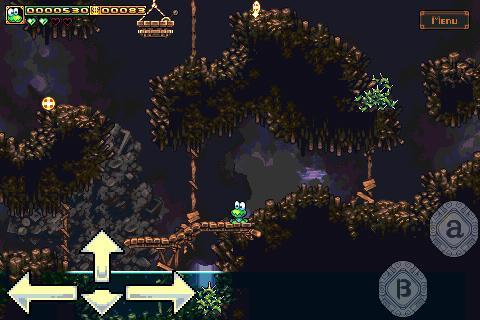Continuing the retro-style gaming trend found in Mega Man 10 and Super Quickhook, Frogatto brings us back to a simpler time in videogame history, a time of gorgeously detailed 2D sprites, a time of running, jumping and joyful enemy slurping. And although it looks like a 16-bit platformer, Frogatto has plenty of conveniences to appease the modern gaming sensibility.
In Frogatto you play as a frog (what else?), trying to make his way in the world. To do this, you’ll wander around many sprawling levels, looking for friends and associates to give you work. When you come upon these characters, they’ll offer you money to do things like bring back a certain type of enemy or find a key. It’s all pretty basic videogame stuff, but the dialog is laced with much-appreciated humor.
Your moves in Frogatto are run, jump, swim, ground-pound, and slurp. This last one works just like it does for Yoshi in the Mario games: your tongue flicks out and pulls any enemies small enough into your mouth. The only difference is that you can’t swallow them. You must spit them out, either into other enemies, killing them both, or onto the ground, which lands them upside-down and vulnerable for several seconds, allowing you to stomp them for the kill.
This is a perfectly acceptable move set for a platformer, but the controls can be problematic. While we’ve certainly played games with worse onscreen D-pads, the one in Frogatto takes some getting used to. It can be stiff and seem unresponsive at first, particularly when jumping. We were able to acclimate to it eventually, but the initial hurdles may make some players give up early on. What we never got used to is the horrendous analog stick that replaces the D-pad when you go underwater in the game. If your thumb slips outside of the small circle– which it often does– the game completely stops registering your input. This leads to many undeserved hits and much frustration. Great 2D platformer controls can be done on iDevices– just look at Soosiz– but Frogatto isn’t there yet.

The levels are linked together with a world map, but you rarely see it because the environments are huge, giving the game an open-world, Metroidvania-type feel. While this is mostly a great feature of the game, we occasionally lost track of what we were supposed to be doing. There’s no mission log, so if you’re on a mission when you quit the game, you might forget what you’re supposed to be doing by the next time you boot it up. This isn’t a huge problem, but it caused us to replay sections now and then.
But if you have a good memory and can get past the controls, there’s a lot to love about Frogatto. The environments are full of platforms, moving elements, enemies of all kinds, and creative bosses. To help you take on these challenges, you have Zelda-like heart containers that let you absorb multiple hits before dying. You can also find additional heart containers along the way. And when you do die, you’re put back to the last checkpoint you reached, which usually isn’t far. Additionally, you have unlimited lives, so you don’t have to worry about game-ending mistakes.
Another great thing about Frogatto is the in-game store, where you can buy items to pump up your abilities. For instance, one item extends the length of your tongue and one lets you spit enemies farther, while others unlock new kinds of power-ups in the world. These upgrades are very helpful as you progress, because the difficulty definitely ramps up as you get further in the game.
So except for our occasional issues with the controls and figuring out what you’re supposed to be doing, Frogatto is a wholly enjoyable retro platformer. It has plenty of level variety and gameplay elements, plus awesome character upgrades and unlockable power-ups.